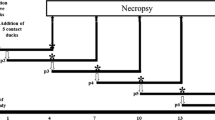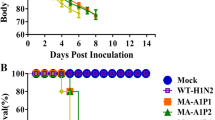Summary
A hepatotropic variant of avian influenza virus A/Turkey/England 63 (Hav 1, Nav 3) was selected by serial passages in mouse liver. Adaptation to this organ was established after 13in vivo passages and was found to improve during further passages as shown by increasing rates of replication in livers of ICR mice. The mutant virus finally selected was stable and differed from the original virus mainly in lethality upon intraperitoneal injection in mice, in its ability to grow to high titers in livers of susceptible animals and in plaque morphology in chick embryo fibroblasts. No differences were detected in hemagglutination inhibition and neutralization by standard mouse antisera. Pathogenicity for the liver was independent of the route of inoculation, included other laboratory animals sensitive to influenza virus and could be inhibited by amantadine. Fatal hepatitis in 50 per cent of susceptible mice by the intraperitoneal route required from 10 to 20 EID50. Pathological changes consisted of severe necrosis of liver parenchyma accompanied by release of F antigen into the serum and were apparently due to virus replication in hepatic cells as evidenced by immunofluorescence.
The main implications of this animal model for studies on experimental hepatitis and on myxovirus-host interactions in an organ not usually associated with influenza are discussed.
Similar content being viewed by others
References
Bingen-Brendel, A., Batzenschlager, A., Gut, J.-P., Hirth, C., Vetter, J. M., Kirn, A.: Etude histologique et virologique de l'hépatite dégénérative aigue provoquée par le FV 3 (frog virus 3) chez la souris. Ann. Inst. Pasteur122, 125–142 (1972).
Burch, G. E., Tsui, C. Y., Harb, J. M.: Hepatitis in mice infected with Coxsackie virus B1. Brit. J. exp. Path.54, 249–254 (1973).
Davies, W. L., Grunert, R. R., Haff, R. F., McGahen, J. W., Neumayer, E. M., Paulshock, M., Watts, J. C., Wood, T. R., Hermann, E. C., Hoffmann, C. E.: Antiviral activity of 1-adamantanamine (amantadine). Science144, 862–863 (1964).
Davies, W. L., Grunert, R. R., Hoffmann, C. E.: Influenza virus growth and antibody response in amantadine-treated mice. J. Immunol.95, 1090–1094 (1966).
DeLay, P. D., Casey, H. L., Tubiash, H. S.: Comparative study of fowl plague virus and a virus isolated from man. Publ. Health Reports82, 615–620 (1967).
Fravi, G., Lindenmann, J.: Induction by allogeneic extracts of liver-specific precipitating autoantibodies in the mouse. Nature218, 141–143 (1968).
Friedewald, W. F., Hook, E. W.: Influenza virus infection in the hamster. A study of inapparent virus infection and virus adaptation. J. exp. Med.88, 343–353 (1948).
Gerber, A., Sauter, C., Lindenmann, J.: Fowl plague virus adapted to human epithelial tumor cells and human myeloblastsin vitro. I. Characteristics and replication in monolayer cultures. Arch. ges. Virusforsch.40, 137–151 (1973).
Gerber, A., Sauter, C., Lindenmann, J.: Fowl plague virus adapted to human epithelial tumor cells and human myeloblastsin vitro. II. Replication in human leukemic myeloblast cultures. Arch. ges. Virusforsch.40, 255–264 (1973).
Grunert, R. R., McGahen, J. W., Davies, W. L.: Thein vivo antiviral activity of 1-adamantanamine (amantadine). I. Prophylactic and therapeutic activity against influenza viruses. Virology26, 262–269 (1965).
Haller, O., Bucher-Nurminen, A., Lindenmann, J.: Early events in myxovirus replication: immunofluorescent spots. Arch. Virol.47, 269–277 (1975).
Haller, O., Lindenmann, J.: Host-cell antigen potentiated by incomplete growth cycle of influenza virus. J. Natl. Cancer Inst.54, 459–464 (1975).
Henle, W., Henle, G.: Studies on the toxicity of influenza viruses. II. The effect on intra-abdominal and intra-venous injection of influenza viruses. J. exp. Med.84, 639–660 (1946).
Hoyle, L.: “The Influenza Viruses”, Virology Monographs 4. Stuttgart: Springer, 1968.
Levaditi, C., Haber, P.: Recherches sur le virus de la peste aviaire pathogène pour la souris. Ses affinités pour les néoplasmes. Rev. Immunol.3, 5–24 (1937).
Lindenmann, J., Lane, C. A., Hobson, D.: The resistance of A2G mice to myxoviruses. J. Immunol.90, 942–951 (1963).
Lindenmann, J., Klein, P. A.: Viral oncolysis: increased immunogenicity of host cell antigen associated with influenza virus. J. exp. Med.126, 93–108 (1967).
McGahen, J. W., Hoffmann, C. E.: Influenza infections of mice. I. Curative activity of amantadine HCl. Proc. Soc. exp. Biol. Med.129, 678–681 (1968).
Mims, C. A.: Rift valley fever virus in mice. VI. Histological changes in the liver in relation to virus multiplication. Austr. J. exp. Biol. Med. Sci.35, 595–604 (1957).
Mims, C. A.: Aspects of the pathogenesis of virus diseases. Bact. Rev.28, 30–71 (1964).
Mims, C. A.: An analysis of the toxicity for mice of influenza virus. II. Intravenous toxicity. Brit. J. exp. Path.41, 593–598 (1960).
Oxford, J. S., Logan, I. S., Potter, C. W.:In vivo selection of an influenza A2 strain resistant to amantadine. Nature226, 82–83 (1970).
Pereira, H. G., Tumova, B., Law, V. G.: Avian influenza A viruses. Bull. WHO32, 855–860 (1965).
Radwansky, Z.: Pathomorphology of experimental influenza. II. Liver. Acta Med. Pol.X, 353–362 (1969).
Rosenmund, A.: Ein leberspezifisches Antigen im Serum von Leberkranken. Schweiz. Med. Wschr.101, 1023–1026 (1971).
Sauter, Ch., Bächi, Th., Lindenmann, J.: Human mammary carcinoma cell line: susceptibility to infection by an avian myxovirus. Europ. J. Cancer11, 59–63 (1975).
Smith, J. B., Iverson, G. M.: Occurrence of liver-specific antigen in adult human serum. Clin. exp. Immunol.13, 209–212 (1973).
Spigland, I., Grose, C.: Hepatitis associated with influenza A0 (Hong-Kong) infection. Abstr. Ann. Meeting Amer. Soc. Microbiol., Miami Beach, February 1973, p. 216.
Schild, G. C., Sutton, R. N. P.: Inhibition of influenza virusesin vitro andin vivo by 1-adamantanamine hydrochloride. Brit. J. exp. Path.46, 263–273 (1965).
Walters, M. N.-I., Joske, R. A., Leak, P. J., Stanley, N. F.: Murine infection with reovirus. I. Pathology of the acute phase. Brit. J. exp. Path.44, 427–436 (1963).
Author information
Authors and Affiliations
Additional information
With 10 Figures
Rights and permissions
About this article
Cite this article
Haller, O. A mouse hepatotropic variant of influenza virus. Archives of Virology 49, 99–116 (1975). https://doi.org/10.1007/BF01317530
Received:
Accepted:
Issue Date:
DOI: https://doi.org/10.1007/BF01317530




